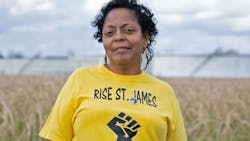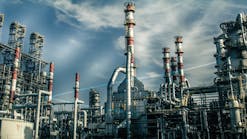Ethylene complex delay reinforces need to address social, environmental justice
Despite Louisiana’s more-than-a-century long history of accommodating US oil and gas operations with relative ease, recent events in the state related to siting and construction of a major petrochemical complex serve as a warning to operators and regulators alike that neither industry nor government agency is immune to strengthening public awareness of and preference for ethical energy development.
In 2015, Taiwan-based Formosa Petrochemical Corp. (FPC) revealed it was evaluating a plan to build a grassroots $9.4-billion ethane cracking and petrochemical complex along the west bank of the Mississippi River in St. James Parish, La. (Fig. 1). After 3 years of planning and preliminary development, Louisiana Economic Development (LED) in 2018 confirmed FPC subsidiary FG LA LCC (FG LA) would build and operate the proposed Sunshine megacomplex that—designed specifically to run on then-oversupplied and cost-advantaged North American shale gas feedstock—would be built on a 2,400-acre site just downriver from the Sunshine Bridge, in Welcome, La. (OGJ Online, Apr. 24, 2018).
Incentivized by an economic package from Louisiana that included a $150-million/year, 10-year industrial tax exemption, LED initial project data showed the complex was scheduled to begin construction in June 2019 for startup in June 2022. Hampered by delays since its inception, however, FG LA’s Sunshine development remained stalled as of late-July 2021 amid legal challenges to project permitting based on claims of environmental racism by local community groups, as well as ongoing concerns of steadily rising costs made worse by the coronavirus (COVID-19) pandemic.
Alongside presenting a current overview of FG LA’s proposed Sunshine complex, this article examines efforts by local communities to hold the operator as well as local, state, and federal regulators accountable for responsible project development.
Proposed Sunshine project
While FG LA has refrained from directly confirming unit-specific details of the Sunshine project publicly, documents published by the Louisiana Department of Environmental Quality (LDEQ) as part of its January 2020 approval of the company’s Part 70 (Title V) operating and prevention of significant deterioration (PSD) permits show the complex—which is slated for two-phased construction—will include 10 major units for production of ethylene, propylene, ethylene glycol (EG), high-density polyethylene (HDPE), low-density polyethylene (LDPE), linear low-density polyethylene (LLDPE), and polypropylene.
To support operation of main production units, the complex will also house plants for electric power and steam generation, wastewater treatment, storage, loading, and associated flaring.
Most recently scheduled for startup in 2025 as of the 2020 permit approvals, Phase 1 of the complex was to include the following plants and support installations:
- Ethane-based cracker to produce 1.2 million tonnes/year (tpy) of ethylene mostly for use as feedstock in the complex’s downstream plants, but also occasionally for shipment to third parties via pipeline.
- Plant using an oxidation and hydrolysis process to produce 800,000 tpy of EG from ethylene.
- EG plant to produce 800,000 tpy of glycols—primarily monoethylene glycol, as well as some diethylene glycol and polyethylene glycols—by first reacting ethylene and oxygen to form ethylene oxide, then catalytically converting the EO into glycols using carbon dioxide and water.
- Plant to produce 400,000 tpy of HDPE pellets by polymerizing ethylene using comonomer (1-butene), hydrogen, hexane, and several catalysts.
- Plant that polymerizes ethylene with comonomers and a mix of catalysts to produce 400,000 tpy of various HDPE grades.
- Plant to produce 400,000 tpy of various grades of LLDPE pellets by polymerizing ethylene with a mix of comonomers, catalysts, and additives.
- Propane dehydrogenation plant (PDH) plant to produce 600,000 tpy of polymer-grade propylene via dehydrogenation of propane over a catalyst.
- Plant to produce 600,000 tpy of various polypropylene grades by polymerizing propylene (received from the PDH plant) with comonomers and a mix of modifiers to adjust molecular weight and physical properties.
- Logistics plant that includes storage and loading installations for liquid and gaseous materials produced at the complex.
- Utility plant to house air compressors, a raw water-demineralized water treatment plant, and two boilers for steam generation to support site-wide operations.
- Central wastewater plant that includes systems for treating organic and inorganic wastewater streams, as well as sludge generated by the plant’s treatment trains.
Alongside additional equipment for production of steam and electricity—including two gas turbines with heat recovery steam generators and a boiler—Phase 2 of the Sunshine complex also will add another:
- S1.2-million tpy ethylene plant.
- 800,000-tpy EG plant.
- 400,000-tpy HDPE plant.
- 400,000-tpy LLDPE plant.
Phase 2—which, as of January 2020, was scheduled for commissioning in 2029—also will include a plant for production of various grades of LDPE pellets via polymerization of ethylene using a mix of comonomers, catalysts, moderators, modifiers, initiators, and additives, according to LDEQ.
After receiving a permit and authorizations to begin preliminary construction under the US Clean Water Act (CWA), Rivers and Water Act (RWA), National Environmental Policy Act (NEPA), and National Historic Preservation Act (NHPA) from the US Army Corps of Engineers (USACE) in September 2019, FG LA started limited works to clear, grade, excavate, and place fill and aggregate material at the project site, LDEQ documents showed.
Following LDEQ’s issuance of Title V and PSD permits in early 2020, and with final investment decision (FID) due by yearend, FG LA was in the process of undertaking major works on Sunshine until a combination of pandemic-related restrictions and mounting litigation forced the operator to entirely halt activities directly related to construction, according to a series of FA LA releases and legal filings.
Arrested development
Though encountering financial delays and community opposition throughout its early development, the Sunshine project faced the beginning of its most formidable roadblocks beginning in late 2019 when faith-based grassroots organization RISE St. James revealed that, during public hearings to obtain a land-use permit from local officials, FG LA failed to inform the predominantly black, low-income residents of St. James Parish—situated in the heart of an 85-mile stretch of land along the Mississippi River between Baton Rouge and New Orleans with a high concentration of refining and petrochemical plants—that unmarked graves of enslaved people had been discovered at the proposed project site (OGJ, Jan. 6, 2020, p. 14).
Further, and despite RISE St. James’ consistent public engagement on the issue in other contexts, neither FG LA nor state authorities notified local communities the complex would be built on grounds formerly occupied by two 19th-century sugarcane plantations that housed cemeteries containing remains of enslaved people, the group said in a filing to LDEQ. Instead, RISE St. James discovered the history of the project’s site only after submitting a formal public records request to LDEQ for documents, which showed FG LA and the state held detailed discussions about these cemeteries starting as early as July 2018. E-mails obtained through the records request also revealed an attorney for FG LA, after learning of evidence of burial sites, contacted state officials to ask whether the state issued any type of permit that would allow exhumation of discovered remains, if found, “quickly, within days” to enable ongoing site development and allow FG LA to avoid the “difficult” alternative of having to reconfigure its site plan, according to legal filings.
Based on what RISE St. James described as FG LA’s “lack of candor and transparency during the permitting process, as well as its apparent disregard for human dignity of historically enslaved people and their surviving descendants in the region,” the organization subsequently petitioned LDEQ to deny FG LA’s air permit applications.
While RISE St. James’ request ultimately failed to impact the state agency’s January 2020 decision to approve Sunshine’s Title V and PSD land use permits, subsequent lawsuits challenging both USACE and LDEQ permits filed by local and national environmental organizations in reaction to what were perceived as the FG LA and regulators’ indifference to community concerns succeeded.
On Jan. 15, 2020, the Center for Biological Diversity, Healthy Gulf, RISE St. James, and the Louisiana Bucket Brigade filed a federal lawsuit asking the US District Court for the District of Columbia to invalidate USACE’s September 2019 clearance for FG LA to proceed with the project on grounds that, in granting authorization, USACE violated multiple US statutes and their implementing regulations, including:
- CWA and RWA, by ignoring consequences of construction that pose threats to human health and the environment, such as the destruction of wetlands that help mitigate the area’s susceptibility to flooding, land loss, and storm surges, as well as the complex’s scheduled discharge of pollutants—including carcinogens, endocrine disruptors, and plastic pellets—into the region’s air and the Mississippi River (Fig. 2).
- NEPA, by not preparing a NEPA-mandated environmental impact statement (EIS) for the project.
- NHPA, by preemptively concluding the project would have “no effect” on plantation burial sites based on FG LA-produced site cemetery surveys instead of waiting on a more detailed historic site survey provided by an independent researcher unaffiliated with FA LA or the state.
In a later response to the federal lawsuit, the USACE on Nov. 4, 2020, notified the DC court it was voluntarily suspending FG LA’s project permit to reevaluate what appeared to be “an element of the permit…[involving the alternative-site analysis under the CWA that] warrants additional evaluation,” according to USACE’s filing.
While USACE’s suspension of the permit required FG LA to stop major construction on the project, the federal agency did allow certain site-security preconstruction activities to continue, including work on a related highway project and local drainage improvements, FG LA said in March 2021 and November 2020 releases.
With USACE’s reevaluation process to decide whether it will reinstate, modify, or revoke FA LA’s permit still underway, the lawsuit remained unresolved as of late-July 2021.
At the state level, RISE St. James and fellow petitioners filed a suit on Feb. 14, 2020, in Louisiana’s 19th District Court appealing LDEQ’s approval of FG LA’s Title V and PSD permits on myriad violations of the US Clean Air Act (CAA) and state-related regulations governing CAA’s implementation, according to the legal filing.
Alongside highlighting LDEQ’s disregard of land-use issues related to FG LA’s concealment and attempted evasion of preserving the historical burial grounds at the project site, the state lawsuit cited a failure on LDEQ’s part to conduct a proper environmental justice analysis, as the permit approvals came despite factual evidence the proposed complex’s anticipated emissions—some of which FG LA in filings to LDEQ conceded surpassed CAA allowable limits—would more than double toxic air emissions in St. James Parish and more than triple levels of cancer-causing chemicals across the predominantly black communities of the region.
In a subsequent action on the case in which LDEQ and FG LA sought to prevent inclusion of additional information related to project-area environmental and demographic indicators that could force LDEQ to revisit its permitting decision, presiding 19th District Judge Trudy White determined the information—specifically, data from the US Environmental Protection Agency’s environmental justice (EJ) mapping and screening tool on populations in the project’s Welcome location—to be material, and as such, that it must be included. According to White’s June 4, 2021, order, LDEQ has until Aug. 10, 2021, to determine whether it will modify its findings and decision to grant the permits based on this new information.
As of May 2021, challenges to St. James Parish Council’s 2019 land use approval for the Sunshine project also were underway, according to releases from RISE St. James and intervenor the Center for Constitutional Rights.
Soaring costs, diminishing returns
With a timeframe for resolution of its legal battles still uncertain and ongoing delays to construction inevitable, FG LA’s Sunshine project also faces uncertainty regarding its long-term profitability.
In its independent report on the proposed complex published March 2021, the Institute for Energy Economics and Financial Analysis (IEEFA) concluded that, under current and predicted market conditions, the project no longer remains economically viable due to rising global ethylene production capacity that will result in oversupply, comparatively lower prices for plastics and petrochemicals vs. the project’s initial planning phase, and increasingly stringent climate-related regulations that will further limit demand for its production.
While IEEFA notes enduring social opposition amid judicial findings of environmental racism already on record as additional factors mitigating against development, the largest hurdle FG LA must now clear will be the project’s rising cost of construction. Citing the Taiwan Rating Service’s October 2020 ratings report on Formosa Plastics Group—parent company of FPC and FG LA—IEEFA said the cost of completing Sunshine has risen to more than $12 billion, about $3 billion higher than its originally projected cost.
Sunshine’s future
Aside from occasional interviews with select media outlets and sporadic news releases, FG LA has limited its discussion of specific plans for the Louisiana complex.
In late-July 2021, however, Janile Parks, FG LA’s director of community and government relations, responded via e-mail to OGJ confirming an indefinite delay to project FID.
“The widespread impacts of a global pandemic, including the challenge it creates in evaluating construction costs and the restrictions it has placed on international travel, are being felt across all industries and businesses, including FG LA,” Parks said.
Confirming late-2020 statements made by Keh-Yen Lin, Parks said the economic impact of COVID-19 has contributed to difficulty in evaluating construction and other costs stemming from uncertainties related to the pandemic. Ongoing legal proceedings also are contributing to the delay, according to the operator.
“As a result, FG LA has deferred major construction on [the project] until the pandemic has subsided and-or effective vaccines are widely distributed,” Parks said.
Despite the delay, Parks said FG remains committed to the project and continues to monitor all relevant factors closely.
Notably, FG LA wrote LDEQ on June 4— the same day the 19th Circuit Court remanded LDEQ’s permitting decision back to the agency for reconsideration—to request an 18-month extension on the Sunshine project’s previously issued PSD permit and authorization to construct, which was to expire on July 6, 2021, according to a copy of the letter obtained by OGJ.
In a separate letter dated July 6, 2021, obtained by OGJ, LDEQ granted FG LA’s request, extending the operator’s deadline to begin construction of the complex until Jan. 6, 2023.
In a series of recent releases on the matter, however, Sharon Lavigne—founder and president of RISE St. James—has reiterated her commitment to keeping Formosa out of St. James Parish and ensuring environmental justice for her community (Fig. 3).

Robert Brelsford | Downstream Editor
Robert Brelsford joined Oil & Gas Journal in October 2013 as downstream technology editor after 8 years as a crude oil price and news reporter on spot crude transactions at the US Gulf Coast, West Coast, Canadian, and Latin American markets. He holds a BA (2000) in English from Rice University and an MS (2003) in education and social policy from Northwestern University.



